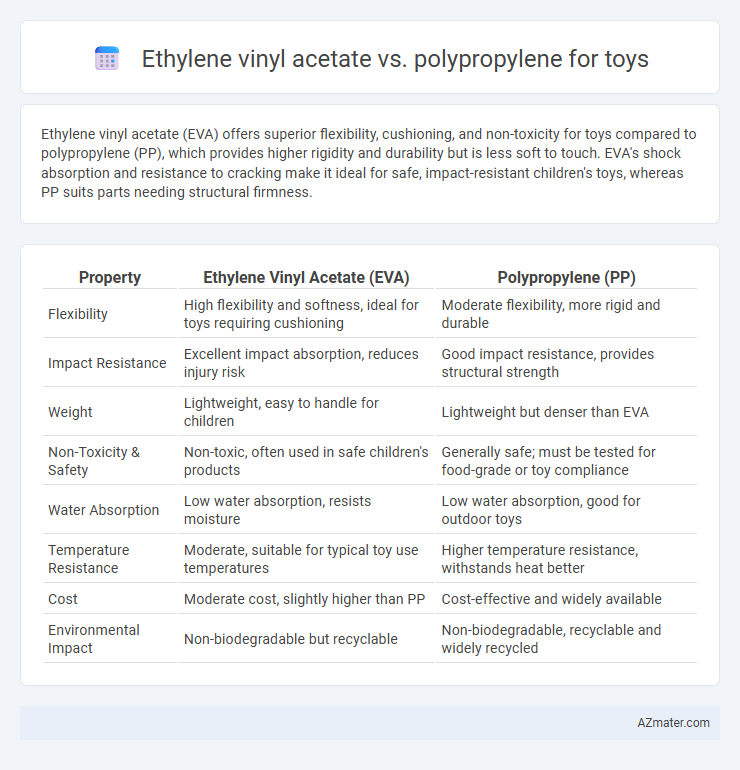Ethylene vinyl acetate (EVA) offers superior flexibility, cushioning, and non-toxicity for toys compared to polypropylene (PP), which provides higher rigidity and durability but is less soft to touch. EVA's shock absorption and resistance to cracking make it ideal for safe, impact-resistant children's toys, whereas PP suits parts needing structural firmness.
Table of Comparison
| Property | Ethylene Vinyl Acetate (EVA) | Polypropylene (PP) |
|---|---|---|
| Flexibility | High flexibility and softness, ideal for toys requiring cushioning | Moderate flexibility, more rigid and durable |
| Impact Resistance | Excellent impact absorption, reduces injury risk | Good impact resistance, provides structural strength |
| Weight | Lightweight, easy to handle for children | Lightweight but denser than EVA |
| Non-Toxicity & Safety | Non-toxic, often used in safe children's products | Generally safe; must be tested for food-grade or toy compliance |
| Water Absorption | Low water absorption, resists moisture | Low water absorption, good for outdoor toys |
| Temperature Resistance | Moderate, suitable for typical toy use temperatures | Higher temperature resistance, withstands heat better |
| Cost | Moderate cost, slightly higher than PP | Cost-effective and widely available |
| Environmental Impact | Non-biodegradable but recyclable | Non-biodegradable, recyclable and widely recycled |
Introduction to Ethylene Vinyl Acetate (EVA) and Polypropylene (PP)
Ethylene vinyl acetate (EVA) is a flexible, rubber-like polymer known for its softness, durability, and excellent shock absorption, making it ideal for toy manufacturing that requires cushioning and impact resistance. Polypropylene (PP) is a rigid, lightweight thermoplastic with high chemical resistance and fatigue durability, commonly used in toys that demand structural strength and long-lasting performance. Choosing between EVA and PP depends on the desired toy characteristics, including flexibility, safety, and tactile feel.
Chemical Composition and Structure Comparison
Ethylene vinyl acetate (EVA) consists of copolymerized ethylene and vinyl acetate units, which give it a flexible, rubber-like structure with excellent shock absorption ideal for toys requiring softness and durability. Polypropylene (PP) is a semi-crystalline polymer made from propylene monomers, featuring a more rigid and crystalline structure that offers higher tensile strength and chemical resistance suitable for hard, impact-resistant toy parts. The chemical composition difference, where EVA incorporates polar vinyl acetate groups and PP is a non-polar hydrocarbon polymer, significantly influences their mechanical properties and suitability for different toy applications.
Physical Properties: EVA vs Polypropylene
Ethylene vinyl acetate (EVA) offers superior flexibility and impact resistance compared to polypropylene, making it ideal for soft, safe toys that require cushioning and flexibility. Polypropylene, a rigid thermoplastic, excels in high tensile strength and chemical resistance, providing durability and shape retention for solid, hard toys. EVA's lower density enhances lightweight toy design, while polypropylene's higher melting point supports heat resistance during manufacturing.
Safety and Non-Toxicity for Children
Ethylene vinyl acetate (EVA) is widely favored in toy manufacturing due to its non-toxic properties, flexibility, and softness, reducing choking hazards and injury risk for children. Polypropylene (PP), while also non-toxic and used in toys, is harder and less flexible, which can pose safety concerns such as breakage under stress. Both materials must meet stringent safety standards, but EVA's cushioning nature and chemical stability offer enhanced protection against harmful substances, making it a safer choice for sensitive, child-focused products.
Durability and Longevity in Toys
Ethylene vinyl acetate (EVA) offers excellent flexibility and impact resistance, making it highly durable for toys that undergo frequent bending and rough handling. Polypropylene (PP) provides superior rigidity and chemical resistance, enhancing toy longevity by preventing deformation and degradation over time. While EVA excels in cushioning and softness, polypropylene ensures long-lasting structural integrity, critical for toys exposed to regular wear and tear.
Flexibility and Softness: Play Experience
Ethylene vinyl acetate (EVA) offers superior flexibility and softness compared to polypropylene, enhancing the tactile experience and safety of toys for children. EVA's rubber-like texture allows toys to bend and compress without cracking, providing a cushioned, comfortable grip that reduces injury risk during play. In contrast, polypropylene is more rigid and less pliable, making it suitable for structured parts but less ideal for toys requiring gentle, flexible handling.
Ease of Manufacturing and Design Versatility
Ethylene vinyl acetate (EVA) offers superior ease of manufacturing due to its low processing temperature and excellent flexibility, allowing for seamless molding and intricate designs in toy production. Polypropylene (PP) provides robust mechanical strength and chemical resistance but requires higher processing temperatures, which can limit design intricacy and extend production times. The choice between EVA and PP hinges on prioritizing design versatility and softness versus durability and cost-efficiency in toy manufacturing.
Cost-Effectiveness for Toy Production
Ethylene vinyl acetate (EVA) offers superior cushioning and flexibility at a higher material cost compared to polypropylene (PP), which is more rigid and lightweight but less impact-resistant. Polypropylene remains more cost-effective for large-scale toy production due to its lower price and ease of molding, reducing manufacturing expenses. However, EVA's durability and soft texture can enhance toy safety and longevity, potentially lowering replacement costs in premium product lines.
Environmental Impact and Recyclability
Ethylene vinyl acetate (EVA) is a flexible, non-toxic polymer that is partially recyclable and generally considered more environmentally friendly due to its lower carbon footprint and non-release of harmful chemicals during disposal. Polypropylene (PP), a widely used thermoplastic in toy manufacturing, offers better recyclability through established municipal recycling programs but poses environmental concerns due to its longer degradation time and potential release of microplastics. In summary, EVA presents advantages in eco-safety and biodegradability, while PP is favored for broader recycling compatibility despite its persistence in the environment.
Conclusion: Choosing the Best Material for Toys
Ethylene vinyl acetate (EVA) offers superior flexibility, impact resistance, and softness, making it ideal for safe, cushioned toy surfaces suitable for children. Polypropylene (PP) provides excellent durability, chemical resistance, and rigidity, perfect for hard, structural toy components requiring longevity and strength. Selecting between EVA and PP depends on the toy's functional requirements--EVA excels in soft, flexible parts, while PP is preferred for robust, durable elements.

Infographic: Ethylene vinyl acetate vs Polypropylene for Toy
 azmater.com
azmater.com